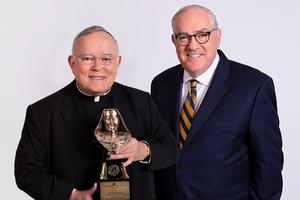Pornography: The Enemy of Human Love
EDITORIAL: The Register welcomes the U.S. bishops’ new effort to make the battle against an ancient, but newly revitalized, enemy of human love and dignity a top concern for the Catholic Church and for the nation.

A diocesan ministry leader points to the “wake-up call” that brought home the scope of America’s growing obsession with pornography: It was the news that a third-grader at a local Catholic school had shown his classmates graphic pictures on a tablet device and then explained how to erase the history of those images so parents wouldn’t find them.
Patrick Trueman, the president and CEO of the National Center on Sexual Exploitation, recounts another disturbing story of early exposure to pornography: A mother recently contacted him because her 6-year-old daughter had become absorbed with looking for pornographic images. The girl’s problem, Truman told the Register, was finally traced to graphic materials she had seen at her daycare program.
These two stories highlight the steady advance of explicit sexual images and films from outlier status to mainstream acceptance. Free, easily accessible online pornography sites have brought hard-core images into the home, roiling, and sometimes ending, marriages and tainting the innocence of the young.
Meanwhile, as the public becomes desensitized and the stigma once associated with pornography recedes, scenes depicting sexual violence continue to appear on music videos, top-rated television shows like Game of Thrones, and, of course, best-selling novels like Fifty Shades of Grey.
Yet, even as pornography becomes ever more embedded in the culture, most Catholic pastors and educators have been slow to raise the alarm or provide practical solutions. Catholic high schools sponsor programs that explain the dangers of drug and alcohol addiction, but the damage wrought by an obsession with pornography often is ignored.
Meanwhile, the Centers for Disease Control and Prevention provides a trove of information on the dangers of smoking, but scant research on the public-health impact of pornography.
Hopefully, that pattern of neglect will soon be challenged by the U.S. bishops. At their Fall General Assembly Nov. 16-19 in Baltimore, the U.S. bishops will vote on a proposed formal statement, “Create in Me a Clean Heart: A Pastoral Response to Pornography.”
“As a response to the pastoral crisis brought about by the production and use of pornography, the formal statement intends to offer a comprehensive treatment of this important topic,” said Bishop Richard Malone of Buffalo, N.Y., the chairman of the U.S. bishops’ Committee on Laity, Marriage, Family Life and Youth, in a statement released before the annual meeting. “It is directed primarily at Catholic leaders and parents, though with an eye to all who struggle with or are affected by pornography.”
If the statement is approved, it will alert the faithful about a festering problem that has failed to draw a sufficient response at all levels of the Church. But Catholic leaders should also use this moment to engage the government’s complacency and make this problem a top public-health issue.
“Confronting the public-health crisis of pornography requires leadership at every level, and it starts at the top,” agreed Elise Italiano, a spokeswoman for Bishop Paul Loverde of Arlington, Va., one of a handful of Catholic leaders consistently raising the alarm about the damage inflicted by pornography.
“Bought With a Price,” Bishop Loverde’s pastoral letter on pornography, has been used to educate adults and children at the parish level in chastity formation and safe-environment training. Priests make it available as a resource for those preparing for confession.
Bishop Loverde, Italiano told the Register, has gone to the “margins to shed light on this grave evil, which thrives in darkness, shame and silence.” His goal is for “all people of goodwill to courageously confront this crisis across a broad spectrum of advocacy, prevention, catechesis, accountability and, of course, conversion and healing.”
Courage is needed, say experts like Trueman — a former chief of the child exploitation and obscenity section, criminal division, for the U.S. Department of Justice — because so many adults have been drawn into pornography addiction. This dark reality has helped to delay an effective campaign to warn young people of the damage pornography can cause.
He strongly urges parents and Catholic educators to proactively and effectively teach young people that pornography is a toxic substance that can damage their minds and hearts and normalize sexual exploitation.
Groups like “Fight the New Drug,” which warns that “Porn kills love,” are already sharing this message through powerful online videos. As local dioceses step up their own efforts to educate the faithful, they should take a page from the best secular initiatives and social research available.
“I have found that teenagers and college students respond well to research about pornography’s negative effects on the brain’s reward center, information about the sexually exploitative nature of pornography and hearing personal testimonies,” said Sam Maier, who leads the “My House” initiative in the Archdiocese of Kansas City, Kan., and regularly travels to local colleges.
“Sex is powerful and fascinating, and people have always abused its appeal,” Archbishop Charles Chaput of Philadelphia told Catholic News Agency during an interview at the Ordinary Synod of Bishops on the Family, where the synod fathers addressed the vast global dimensions of the problem. “But modern technologies make it a lot easier to access and much, much more widespread. It’s an epidemic; or, more accurately, a pandemic. Porn does huge damage to families. It isolates individual family members by creating private sexual obsessions. And it wrecks the intimacy between husbands and wives with notions of ‘perfect’ sex that bear no relation to real human beings. It steals the richness of a long-term, mutually rewarding sexual friendship between husband and wife, and it substitutes a shabby replacement that can never really feed the human heart.”
The Register welcomes the U.S. bishops’ new effort to make the battle against an ancient, but newly revitalized, enemy of human love and dignity a top concern for the Catholic Church and for the nation.
- Keywords:
- archbishop charles chaput
- editorial
- human dignity
- pornography
- u.s. conference of catholic bishops

















